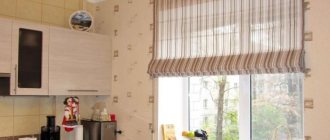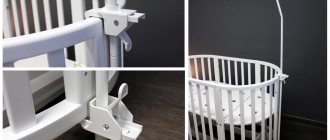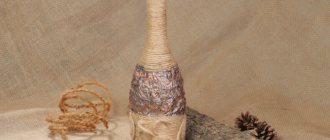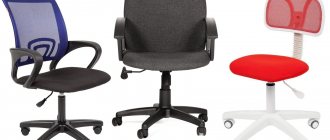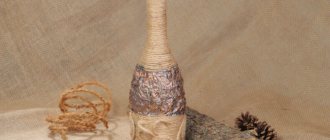Every needlewoman has a desire to beautifully and effectively transform the design of a room and its interior, but not every one of them wants to make any drastic changes or resort to large-scale renovations. One of the simplest, but at the same time effective ways to logically complete the interior or emphasize it is to sew original covers for chairs and stools.
Such design elements can not only please the eye and give old furniture a new life, but also protect it from various types of pollution and pests. To discover this practice, it is recommended that you familiarize yourself with it in full. This material will tell you how to sew a cover for a chair, an attachment for a stool, patterns for chair covers, what fabric to choose for this, and what features the sewing process involves.
The cover can bring back the popularity of an old chair
Benefits of making your own chair covers
Firstly, the covers, which were created by hand, not only meet all the style preferences of the hostess, but are also made conscientiously, from high-quality material. Chairs with backrests and stools in protective covers do not lose any of their practical properties, but acquire new characteristics: beauty, elegance. Removable upholstery protects furniture from premature aging and abrasion.
Simple cover for kitchen chairs
During the sewing process, you can determine how well a particular fabric is suitable for the seat, how it sits and stays on it. It is impossible to check this when purchasing store products.
Important! If the cover is sewn by hand, it will be of high quality and will cost a minimum of money or almost free if fabrics from old things were used for sewing.
Homemade stool covers
The advantages of making “upholstery” with your own hands are obvious:
- The seats will be original and will fit perfectly into the interior of the room if certain requirements are met;
- Furniture that has been improved through “cladding” will become more comfortable and will “live” longer due to its protection;
- Manufacturing will take little material and money, and the appearance of the furniture will change dramatically;
- Removable covers can be easily removed and washed if they get dirty.
Covers not only protect furniture, but also complement the interior
Decoration options
The style of the interior in which the chair will stand dictates the methods of decoration. Laconic minimalism or modernism do not tolerate overload, but will accept a combination of fabrics by color or texture, discreet details: pockets, folds. To decorate cases in a classic interior, the following are suitable:
- long frills;
- edgings emphasizing the clarity of the form;
- thin golden or woven braid;
- imitation of antique lace.
This trend is generally characterized by ceremonial decor and regular geometric shapes.
Rustic style, country and Provence suggest natural fabrics and very cozy finishes:
- frills, ruffles;
- crocheted lace;
- braid with ornament;
- lacing.
Making your own baby high chair and stool
In banquet halls, chair covers with backrests are decorated according to the general style of the room. Beads, satin ribbons, rhinestones, and brooches are used for decoration. Artificial or fresh flowers will also come in handy.
Such “clothing” for furniture will protect new chairs and stools from dust and damage, and will give old ones another chance. In addition, hand-made chair covers will add comfort and beauty to your beloved home. And if you create several sets, then with their help you can update the interior every season.
How to choose a style
Chair decoration is classified according to several factors: style, which includes the shape and function of the products, as well as the material used to make them. The latter will be discussed in detail in the next section.
Depending on the shape of the products, they are divided into several categories:
- Solid ones that fully cover the furniture from external influences. They cover not only the seat, but also the back and legs. They have a strong fixation, which helps to radically change the design of furniture and hide its shortcomings;
You might be interested in this. Patterns for dresses and kimono robe: sewing with your own hands
A one-piece cape, which has already become a traditional option for chairs with a backrest
- Separate, which will include separated covers for the back and seat. Due to this, specific advantages appear: ease of care, since you can easily remove part of the decor and wash it, practicality.
Separate elements are practical and original
- Only sitting. It only covers the seat and the lower part of the chairs. This option is the most practical and requires little time and economic investment.
The cover over the seat reliably protects it from abrasion.
The choice of style also depends on the purpose and functions of the covers, based on which they are divided into:
- Everyday accessories used every day. It is worth remembering that such covers must be washed more often due to constant load. To do this, when choosing a material for them, they rely on dense and highly resistant fabric that is easy to clean;
A simple cape for everyday use
- Solemn. They are intended for festive events and have the main task of decorating the design and causing a “wow” effect among guests, focusing attention on the table. They differ from ordinary ones in that they are usually made from expensive types of fabrics with various decorations in the form of bows, frills, ribbons and draperies.
Formal covers effectively focus attention on yourself and the table
Spanish experience
Spain has long been famous, among other things, for the art of decoration. Spanish decorators decorated the Louvre and Versailles, that means something. Therefore, below we provide Spanish versions of patterns for chair covers. You don't have to learn Spanish to understand them. Firstly, for those who have ever sewed anything, everything is already clear. Secondly, the inscriptions on the patterns and the explanations for them are not the original of Don Quixote; any online translator can easily cope with them. So, for starters, a pattern for a cover for a kitchen chair with a rounded back in Spanish:
Spanish pattern for a kitchen chair cover
Next, an accent cover for a chair in the living room; with a short skirt will go for a kitchen chair:
Spanish pattern for a chair cover in the living room
The third option is a cover for a Viennese or rattan round chair on the patio, on the veranda or, in our opinion, on the dacha:
Spanish pattern for a chair cover with a round seat and back
And finally, a pattern for a decorative cover with a flounce for a wedding; without heart appliqués - for any holiday:
Spanish pattern for a wedding or holiday chair cover
Choosing fabric for sewing
Sewing can be done from a variety of materials. It all depends on the final purpose of the cover. For daily use you need a practical and inexpensive fabric, and for the holidays you need a beautiful and elegant one. In addition, they take into account the room in which the chairs are located, its purpose and its own interior.
Important! For everyday use, you should choose a wear-resistant material that can be removed and washed or knocked out at any time. One of the criteria is also the absence of electrification and absorption of contaminants. Some of the best fabrics for sewing are considered to be cotton, microfiber, linen or silk.
Stylish case in light colors
Cotton fabrics
Among them, the priority is satin, calico, denim or twill. Their key advantage is that they hold their shape well, do not cause allergies in sensitive people and are machine washable. Cotton fabrics are inexpensive and come in a variety of shades, colors and patterns. They also have disadvantages: rapid fading and getting wet.
Cotton covers
Linen fabrics
These include matting, linen itself and canvas. They are environmentally friendly, highly durable, dirt-repellent and can be subjected to intensive machine washing and intensive use. Also, linen does not absorb dirt well, it is hypoallergenic and easy to care for. Rough, minimally processed linen fabrics are ideal for everyday slipcovering. The disadvantages are: difficulty in cleaning and ironing, rough texture. Linen covers are suitable for everyday use in country or ethnic style rooms.
Linen fabric looks practical but beautiful
Flock and microfiber
These materials are new generation materials. Their main advantages were:
- Wear resistance;
- Attractiveness;
- No creasing;
- No deformation when washing.
You might be interested in this: The procedure for sewing a one-piece swimsuit for an overweight woman on your own
Important! Despite this, microfiber and flock cannot be subjected to heat treatment: dry on a radiator and iron. This is not necessary if there is no creasing.
Microfiber chair cover
Silk
Silk fabrics include: brocade, satin, crepe-satin. Their advantages are that they are durable, noble and resilient. Silk fabrics make it possible to create spectacular folds and draperies. There are also disadvantages: high price, demanding care and washing, careful ironing. Such canvases are suitable for creating holiday covers in classical and neoclassical, Indian and Arabic styles.
Silk covers can emphasize the solemnity of the event
Materials and tools
The fabric for chair covers is selected depending on the purpose of the furniture. Inexpensive textiles that are easy to wash and iron are suitable for the kitchen:
- Cotton: calico, teak, satin. It is advisable to duplicate thin material with double thread or a layer of non-woven fabric, so it will hold its shape better.
- Linen looks great due to its texture, but is difficult to iron.
- Fabrics containing synthetic fibers: polycotton, gabardine - wrinkle less and are easy to wash.
Homemade and chemical compositions for cleaning chairs from stains, stages of work
If we talk about new products, then you can pay attention to supplex - elastic knitwear. It easily adapts to shape, does not accumulate static tension, and dries quickly. In addition, this material comes in bright colors, so suitable for the kitchen.
In the living room, chair covers are made from fabric that matches the rest of the textiles:
- jacquard, tweed, velor, flock - they have a rich texture and hold their shape well;
- corduroy and denim are appropriate in a modern interior or a teenager’s room.
Decorating halls for a wedding or other celebration involves elegant, well-draped fabrics. Flashy but inexpensive materials are suitable, since the case will be used for several hours. Optimal options:
- satin and silk are slippery, shiny, flowing fabrics that require lining and reliable fastenings;
- crepe-satin, gabardine, knitwear - their texture is more restrained and allows you to create beautiful frills and draperies;
- taffeta, veil - used to create airy flounces and lush bows.
Moms take different paths when choosing fabric for a highchair cover. Those who need practicality take waterproof materials, others value the baby’s comfort, and still others find a universal but expensive option. Each of them has both advantages and disadvantages:
- Eco-leather - oilcloth-based fabrics are easy to clean and are not afraid of spilled milk. But they are not hygroscopic - in the hot season the child will sweat.
- Velor and knitwear are soft - pleasant to the touch, but they will get dirty, and the cover will have to be washed often.
- NANOtex is a material with microparticles of silver with a water-repellent effect, breathable, does not cause allergies, spilled liquid can simply be blotted with a napkin.
Before cutting, the fabric must be wet-heat treated so that the finished product does not shrink. This is especially important for linen and cotton.
Additional materials that may be needed when sewing:
- lining fabric;
- padding polyester or padding polyester;
- fastenings and fasteners: elastic band, Velcro tape, buttons or zippers;
- braid, fringe, lace and other decorations.
In addition to the sewing machine, you will need: a measuring tape, a marker, scissors, pins and thread.
NANOtex
Velveteen
Denim
Jacquard
Linen
Cotton
How to take measurements and make a pattern?
The first thing you need to do when sewing is to take measurements of the furniture. The pattern directly depends on the design and dimensions of the chair or stool. To take measurements, take material that holds its shape well and cover the chair with it, securing everything with pins. At this stage, they take into account: how much the legs of the chair will be covered, whether there will be fasteners on the back, and so on.
Luxury and functionality combine in brocade
Measurements can also be taken using tracing paper. To do this, a layer of paper is first applied to the seat and secured with pins. After this, a stroke is made along the contour. For allowances, add one and a half centimeters on each side. Subsequently, the parts are cut out. The back is measured in the same way if sewing is done for a chair.
For the front of the cape, measure the length of the legs and the width of the front edge of the product. After this, a given rectangle is drawn on tracing paper, adding 5 cm at the bottom and 10 cm at the sides. To all this add a 1.5 cm seam allowance at the top edge.
Practical and stylish capes
Patterns for the sides of the “skirt” are made in the same way. Add 15 cm to the edge adjacent to the outer part of the back. The pattern is made in several copies. Measuring the outer part of the backrest is done as follows:
- A large sheet of tracing paper is applied to it at the top of the backrest;
- The edges of the outer side are marked;
- Lines are drawn along the legs to the floor;
- Add 5 mi at the bottom and 1.5 cm for the seam allowance.
Translucent cape on the back
Important! Centers are marked at the top and bottom of the patterns, along which the fabric is then folded and cut into two even parts.
Instructions for sewing different models
Dense covers that exactly follow the shape of the furniture consist of a dozen individual parts. Their production requires a high level of skill. But simple chair covers have the same functionality, but at the same time every housewife can create them. Below are step-by-step instructions for some models.
One-piece
The simplest pattern for a chair cover consists of one piece; in this case, the seams can be replaced with ties or fasteners. Sketch construction:
- draw a rectangle according to the dimensions of the seat;
- step back 15 cm from the bottom side and extend the part - the front part of the cuff of the future cover;
- in the same way, build the side parts of the cuff 15 cm wide to the left and right of the seat part;
- Measure the length from the top edge: double back height + thickness + 15 cm (cuff width).
Distinctive features of growing chairs, important selection criteria
Cut out the finished pattern and attach it to the chair. Check the elements for compliance and make adjustments if necessary. Lay the fabric right side down, pin the piece and trace the outlines. Seam allowances are 1 cm on the sides of the cuffs, on all other sections - 1.5 cm on the hem.
Following actions:
- Stitch the side and front cuffs, trim the seam allowance close to the seam at 45°. Press seams.
- Overcast seam allowances. For non-flowing fabrics, the seams may not be processed.
- Fold the bottom edge of the cuffs 0.5 cm, then another 1 cm, stitch along the edge of the hem. Also trim the bottom edge of the back cuff.
- Fold the side seams and press.
- To attach the cover to the chair legs, sew 4 pairs of ties on the wrong side of the cuffs at a height of 7 cm from the bottom edge.
- To connect the side panels of the cover on the front part of the back, sew three hinged loops along the left and right edges, placing them evenly along the height of the back.
- On the back, sew buttons opposite the loops.
DIY chair covers are ready. The front and back parts are connected not only with the help of button fasteners - you can make ties, insert a zipper from the top edge to the bottom edge. If the back of the chair is of small thickness, the edges can be sewn; in this case, when cutting, you need to provide a margin of at least 5 cm for a loose fit so that the cover can be easily removed.
Cover for high chair
The highchair cover consists of three layers: main fabric, padding polyester and lining. In addition to the main part, you need to cut out fastenings in the form of pockets, with which the cape is secured to the upper part of the back and sides.
- Finish the free edges of the pockets. Place them on the lining fabric pieces face to face, align the edges, and baste them to the lining.
- Place the main fabric piece over the lining fabric and baste along the contour. It is important that both parts are facing each other.
- Apply padding polyester to the main fabric piece. Combine edges, baste.
- Sew the cover along the lines, leaving a 10 cm section unsewn to turn it right side out. In corners and rounded areas, cut allowances close to the seam.
- Turn the cover inside out, straighten the corners, iron the edges. Sew up the unstitched area by hand using a blind stitch.
- Place a stitch along the edge at a distance of 1–3 mm.
- On the back, stitch in a random order to secure the soft layer.
- If there are fastening straps, mark the location of the slots and sew them with a stitch for sewing buttonholes.
- Sew an elastic band on the sides, which is threaded under the plastic seat and holds the cape in place.
For round chairs, the back and seat are sewn separately using the same algorithm. The finished parts are sewn together on the wrong side with a stitch placed close to the edge.
Preparing the pattern
Cut out the linings
Short side hem
The lining is sewn to the main fabric
To make the cover softer, it is necessary to lay padding polyester between the material.
Belt holes
Ties
Seat for round stool
To make a soft cover you will need a piece of foam rubber, a piece of fabric and an elastic band of length equal to the circumference of the stool. Step-by-step instruction:
- Make a pattern directly on the fabric: turn the stool over, trace the outline of the seat. Add 10 cm to the edges, cut.
- Fold the edges of the part to a width of 1 cm, tuck and stitch, leaving an unstitched area of 1.5 cm.
- Hook a clothespin onto the edge of the elastic and thread it through the drawstring along the edge of the cover.
- Place foam rubber on the seat of the stool. Holding it with your hand, trim the excess with scissors to the desired shape.
- Place the cover over the foam rubber and tighten the elastic so that the seat holds tightly. Tie or sew the ends.
The cover for the round stool is ready. The foam pad can be attached to the top: stitched or tied with thread in several places. Then the pillow will be as firmly attached to the seat as possible.
Case with long frill
This cape is sewn based on the pattern of a one-piece cover. For the frill, you will need additional measurements: the total length of the three front cuffs, the back cuff and the distance from the bottom edge to the floor. Step-by-step actions:
- Cut out two strips of fabric with a width equal to the length of the frill plus 1 cm seam allowance and 1.5 cm hem allowance. The length of the stripes is 1.5 times the length of the cuffs.
- Fold the bottom twice and hem it. Also process the side cuts.
- Step back 0.5 cm from the top edge and stitch. Pull one thread and gather the fabric to the desired width.
- Distribute the ruffles evenly, securing with pins, and baste to the bottom of the cuffs.
- Sew on the ruffles, overcast and iron the seam. Sew the cuffs on the front side, at a distance of 1–2 mm from the stitching line.
The “skirt” of the cover with folds or pleating is sewn using the same principle.
Step-by-step instructions on how to sew a cover for a chair with a backrest
You can order tailoring from purchased fabric from a craftsman, but it is much more profitable and enjoyable to do it yourself. The only caveat: all measurements must be accurate and take into account seam allowances and fabric shrinkage when washing. For this, one or one and a half centimeters should be enough.
You might be interested in How to make a practical organizer yourself
Instructions for sewing a simple product
To get started, you need to prepare all the necessary materials and tools:
- Threads and needles;
- Sewing machine;
- Adhesive tapes;
- Scissors and awl.
Taking measurements from a standard chair
Step-by-step manufacturing instructions are as follows:
- Make a pattern on tracing paper or film that will fit well on the furniture to take all measurements;
- Cut out a seat from soft synthetic padding and make allowances of 1 cm at the edges and 3 cm at the back;
- Attach the padding polyester to the seat and measure out the recesses for the legs at the back. Cut notches along the contour;
- Determine the height of the cover and, leaving the bottom of the furniture open, measure the sides and back wall of the chair;
Case decorated with bows
- Transfer the pattern to the selected material and cut it out, not forgetting to leave allowances for seams and shrinkage;
- Round the corners on the sides for a better “seat” of the cover;
- Sew all the parts together using a sewing machine. Make notches on the rounded edges to avoid wrinkles in the fabric;
- Sew decorative elements in the form of braid or beads around the perimeter of the seat;
- Try on a chair cover;
Case for children, decorated with a flower
Style selection
The cover for a chair with a back makes a mark. Features:
- Saving - protects from damage, hides flaws. Pos. 1 and 2 in Fig;
- Accentuating - fits furniture into the interior, at the same time complementing and/or completing the concept of its design, poses 3-6;
- Props, pos. 7 and 8 - takes on a leading role in the appearance of the interior, most often together with the tablecloth. This allows you to hide design flaws or obscure decisions that are inappropriate in the circumstances;
- Decorative, pos. 9-11 - mainly at celebrations. In this case, universal covers (see below) make it possible to organize an extensive feast with “different-sized” chairs.
Types of chair covers
It is quite possible to sew chair covers that combine several of these functions, but then you should also be guided by the functional purpose of the cover:
- Everyday and accent - made from durable, hygienic, easy to wash, clean and iron fabrics, see below.
- Prop - since they are not used every day, the requirements for durability and washability of the fabric are reduced, but in return, pomp and luxury are required, otherwise it is impossible to visually draw the main accent of the interior onto the table with chairs.
- Decorative - the main thing here is the possibility of catchy decoration at low cost, the cheapness of the fabric, its minimum capacity for fat and liquids and maximum washability if the covers are reusable, for example. rental It’s clear what the covers and the furniture under them can turn into after a wedding or anniversary if they get wet well.
About capes
Covers for kitchen chairs
Covers for kitchen chairs are often made in the form of simple protective covers, see fig. on right. Make them conceptually accentuated with bows, decorative buttons (see at the end), floor-sweeping skirt, etc. accessories in this case are irrational. However, the kitchen also needs style with accents; especially if they are hosting guests. In this case, knitting will help out: knitted furniture covers are an absolute sign of good taste, skill and wealth of the owners. Meanwhile, chair covers can be crocheted very simply from fragments without a pattern or the ability to knit at all, see next. video:
Video: DIY knitted chair covers
Features of covers for high chairs
If the cover is made for a children's high chair, then the most correct thing would be to make it from hypoallergenic types of cotton fabric that are durable and wear-resistant. This material is breathable and easy to wash. The fabric itself is quite cheap and it wouldn’t be a shame to throw away such a cover if it gets damaged by a little tomboy.
It is best to put a water-repellent cover on the high chair that will wash without problems. Since all furniture has its own design, you will have to take all measurements individually on a chair or on a standard cover.
Children's case in the form of a kitchen game
Important! If the kit included a standard case, then you should carefully examine it and understand where the seams are and what kind of design it has.
The general sewing method is simple:
- Fasten the main fabric and the gasket;
- Place them face to face;
- Sew along the edges, leaving 20 cm unsewn on the side to turn the product inside out;
- Turn out the “upholstery” and straighten it;
Stool seats wear out quickly without a cover
- Fold up the unstitched side and stitch it in any way;
- Mark the places where seat belts should be located if necessary;
- Decorate the product with bows, ruffles, ribbons or thermal appliqués.
Mattress for high chair
Test chair cover made from inexpensive fabric
It is very difficult, without experience, to make an accurate pattern for covers. No matter what, something will go wrong. There are so many models of chairs and options for their manufacture that it is simply impossible to give a ready-made universal pattern for sewing chair covers. Each chair model needs its own pattern, which will take into account all the curves of the back and the angles of the legs. The back may have different widths at the top and bottom, not to mention rounding at the top. The front legs can be straight, the hind legs wide apart, etc.
If possible, it is better to entrust this work to professionals, since all the nuances of sewing covers cannot be learned without practice. But if you decide to sew chair covers with your own hands, then before cutting expensive fabric, first sew a prototype from inexpensive fabric. During the fitting process, make adjustments to the pattern. And only after you have achieved an exact copy of the shape of your chair, you can cut out the final version of the details of the covers from the fabric purchased for them. And also, do not sew covers for chairs from fabrics that are too expensive, otherwise you will have to sew covers for them later. Never sew covers end-to-end. Chairs are not a pillow, and if the cover is a little narrow somewhere, it simply won’t fit on it. A supply never hurts, and you can always remove it; besides, some fabrics may “shrink” after washing.
Other articles:
Master class - sewing a bag from leather The atelier technologist gives a short master class on sewing a women's bag with your own hands from genuine leather.
How to sew curtains with your own hands Most often, the desire to sew chair covers with your own hands arises after replacing the curtains in the kitchen or living room. In some cases, you can even use the same fabric for the covers as for the curtains.
Decorative stitching on a difficult area When sewing a chair cover from coarse thick fabric, the sewing machine may make gaps and break the thread. Read this article, it gives recommendations on how to avoid this.
But to sew a quilted bedspread, with padding made of padding polyester, and with a lining, so that it becomes the main decoration of the bedroom, is not easy, and requires the experience and qualifications of a seamstress
How to sew a bedspread It is not difficult to sew a bedspread with your own hands if it is like a cape on a sofa or bed made of tapestry or patchwork fabric. But sewing a quilted bedspread, with padding made of padding polyester, and with a lining, so that it becomes the main decoration of the bedroom, is not easy, and requires the experience and qualifications of a seamstress.
How to sew a sheet with an elastic band Sheets with an elastic band have become very popular. This is primarily due to the fact that many euro-sized beds have appeared using high spring mattresses, which are simply impossible to fill with an ordinary sheet from a standard bedding set, it is too narrow and therefore constantly “strays” during sleep.
How to sew a pillowcase How to sew a pillowcase for sofa cushions or sew a chair cover with your own hands? The question is quite difficult for those who have never sewed pillowcases or covers themselves. You need to accurately create a pattern, calculate the consumption of calico or satin, and most importantly, sew it correctly so that the seams are even and strong, and the pillowcase matches the size of the pillow and the cover matches the size of the armchair or chair.
DIY patchwork quilt Those who sew a lot probably accumulate a lot of leftover pieces of fabric of different colors. You can sew a bedspread or blanket from a variety of colored pieces. The shape of the flaps can be very diverse; it is not necessary to cut out exact geometric shapes.
Beautiful examples of cases
To expand the reader's creative potential, below are options for beautiful and elegant slipcovers that can restore any furniture to its former glory.
A colorful throwaway fabric can easily change the look of a simple bar stool.
Thus, the pattern for chair covers is not particularly complicated. Anyone, even a novice craftswoman, can do this and other stages of work. There are many classes of styles of covers; they are divided into formal and everyday. Based on this, the material for production, the presence of decorative elements and other things are selected.
How to quickly create a pattern for chair covers with a backrest?
If you are making a pattern for a chair cover with a back, then the basic model is constructed as follows.
- The length line of the back and seat is measured and marked on paper.
- A measurement is taken at the widest point of the seat or backrest and transferred to the drawing.
- On the resulting rectangle, the line connecting the seat and backrest is marked, and another height is added to the backrest to make it double.
- Next, you should separately cut out a rectangle that will be sewn to the seat. Its length is determined by the desired length of the cover.
- All pattern details are transferred to the fabric. Allowances are marked with chalk - 8 cm for each part.
- After this, the details are swept away and stitched together. If necessary, excess allowances are carefully cut off.
After the base of the case is ready, needlewomen can use their creativity and decorate the product with an original finish. This could be a bow on the back or a frilly skirt at the bottom. If you want to make a frill, remember that the calculation of the fabric for it is done as follows: the sum of the sides of the seat is multiplied by three. Then the skirt of the cover will drape beautifully.
Not only an apartment, but also a country house or dacha requires original interior design. In this case, bright chair covers that are easy and quick to sew will suit you. In our case, the seat is round and the back is also round. To create a pattern:
- Measure the diameter of the seat and mark a segment equal to it on the drawing. Draw a circle by hand - geometric precision is not necessary, since the drapery of the fabric will hide minor inaccuracies.
- Measure the height and width of the backrest.
- Draw a triangle for the bow. The wider the base of the triangle, the wider the bow will be.
- The rectangle for the skirt can not be marked on the drawing, but can be immediately cut out of the fabric.
The most common models of this type of product are covers for chairs in the kitchen. This is the most popular room in any home, which means the furniture quickly gets scuffed and dirty. To quickly cut out a convenient model of a rectangular chair cover in the kitchen, you need:
- Transfer the length and width of the seat and backrest onto paper.
- Make the back panel with a train. Its length is determined according to your wishes.
- Draw four rectangles to insert into each corner joint of the back and seat - this way the skirt on the cover will look original, gathered at the sides.
- For the sides of the chair, cut out a separate panel so that the seat cover is sewn from three fragments - the front, the sides and the seat itself.
Material selection
It is recommended to approach the properties of the material very carefully, first of all, pay attention to the purpose for which the covers are made.
- For everyday use. It is necessary to choose hygienic, durable and easy to wash fabrics. It is advisable to choose a color on which dirt is hardly noticeable.
Case for everyday use
- For decoration. The covers give the chairs a completely new, noble look. The fabrics must be expensive and beautiful; sometimes additional decoration elements are used on the covers; they are used only on the most special occasions.
Decorative covers
The correct choice of fabrics significantly increases the time you use covers and makes it possible to change the decor in the room in accordance with specific tasks.
What should covers be combined with?
Professionals do not recommend using wool and viscose fabrics; their characteristics do not meet existing requirements.
What fabrics can be used to sew covers?
| Type of fabric | Short description |
Cotton | Twill, satin, satin, cotton gabardine, etc. The fabrics are cheap, wash well, do not lose their shape, and wear well. Disadvantages - the color fades over time, the fabrics quickly become wet. It is better to use it as temporary protection for chairs; for accent covers it is recommended to use cotton gabardine, and to create country-style interiors you can use denim or cotton canvas. |
Linen | An important advantage of such fabrics is their very high wear resistance and self-cleaning ability. But they don't paint well and are difficult to wash. Linen covers can be used for country furniture. |
Silk | Crepe-satin has shown itself to be excellent: it does not get dirty, is easy to wash and iron, and stretches evenly. Gabardine is of good quality, but it is significantly more expensive. Satin and brocade for covers are not the best choice; they are recommended to be crushed only for decorative covers. The latter has metal threads, does not wash off, and is very difficult to clean. A common drawback of all silk fabrics is that they are slippery, making it difficult to sit on a chair. |
Biflex | Most furniture fabrics are woven using this method; these are materials of universal use. Spandex has proven itself to be excellent, it stretches well and is able to retain its shape for a long time. The fabric is easy to clean and wash. |
Flock and microfiber | Modern materials for upholstery of furniture are kept clean for a long time due to the long pile that attracts dust. Covers made from such fabrics can be used for up to five years, but after that they must be thrown away; it is impossible to clean the products. |
What fabrics are used for chair covers?
Choose your material carefully, taking into account the maximum number of individual factors.




